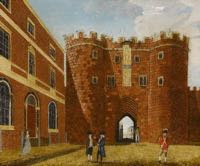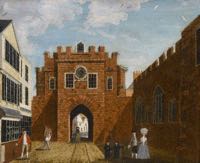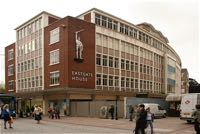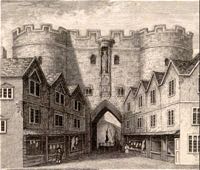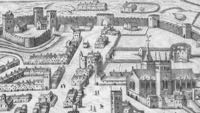
Eastgate and Eastgate House
Page updated 30th January 2017
The demolition, in 2007, of Eastgate House on the corner of the High Street and Paris Street is just the latest chapter in the history of the Eastgate.
It was the Romans who built the city wall with four gates. The Eastgate was always considered to be the second most important after the Southgate. By the time of King Athelstan, the cities defences had crumbled—he strengthened the wall and presumably the gates as well. In 959 Edgar succeeded to the the throne. Jenkins in his History of Exeter wrote:
"The third wife of Edgar was Elfrida, daughter of Orgar, Earl of Devon, the founder of Tavistock Abbey; it is reported of him, that he was of such gigantic stature and strength, that Malmsbury once coming with the King to Exeter, and finding the Eastgate shut and barred, and the Porter absent, he, by the force of his arms only, unhinged the gates from the bars, and with Orgar Earl his foot forced them open."
Whether this anecdote indicates that the gate was in poor repair is uncertain.
William the Conqueror laid siege to the city from the Eastgate, in 1068. He undermined the walls, before the citizens surrendered to him. Another royal rebellion, by Perkins Warbeck in 1497 who claimed that he should have the throne as he was the younger of the Princes in the Tower, was repelled by the Courtenay's in the High Street, after he broke down the Eastgate. The King, Henry VII, stayed at Exeter soon after, to deal with the rebels, and presented the city with his 'hatt of mayntenunce' and sword to be borne through the streets as in the City of London. A statue of Henry VII was placed over the arch to commemorate the event. Jenkins wrote of the statue:
"The exterior arch was very strong and lofty, over which rested a statue of King Henry VII. in a Roman toga, holding a globe and sceptre..."
In 1492, the pipe that carried water from St Sidwell's to Cathedral Green was replaced when sections of passage under Eastgate were tunnelled, as far as St Stephens Church, and a three inch lead pipe laid–it was continued down the High Street, as far as the Carfax, at Fore Street, in a trench. This is now part of the Underground Passage.
According to Samuel Izacke in his Memorials of the City of Exeter in 1457:
"The East-gate of this City by reason of a long standing became ruinous, and fell down in the mid Day without hurting any person."
How much of the gate collapsed is not clear, but it was not until 1511-13 that the gate was completely rebuilt, after further damage caused by Perkin Warbeck's siege in 1497. Robert Poke of Thorverton was engaged to "bild and make Estgate of the Cite to finde all maner of stuffe and he to have for his labor 128l. and to bild 6 votores." In 1512, the Receiver sold 6 acres of Duryard to pay for the rebuilding.
The Salutation Inn
During the first years of the 17th Century, the porters lodge became a popular place to drink, play cards and no doubt, gossip. A few years later, and the occasional tavern had moved to an upper floor, for Mr Newberry was reported to the city authorities for 'for keeping of ill-rule in his house'. Just before the Civil War, a 'wyne bushe' was hung outside, to indicate that drink could be obtained there. The Puritan rulers of the city were not amused by such goings on. By the 18th Century, the rooms were formally known as the Salutation Inn.
Demolished
It was in 1784 that the old gate was finally taken down to allow easier access to the High Street.
On the north side of the High Street was, in the 19th Century, Mark Rowe and Sons, auctioneers and cabinet manufacturers. The building was constructed of red sandstone which was reclaimed from the old Eastgate. On the facade, the statue of Henry VII from the Eastgate was placed in a niche. The clock, that was on the High Street side of the old building, was moved and placed on the frontage of St John's Hospital School.
Eastgate House
The Eastgate House that was demolished in 2005 had its seeds in a building dating back to the 1930's. The Co-op built a modern structure of concrete, on the site of the old Cathedral Dairy. Alongside, in the High Street was the 19th-century Eastgate Arcade, that stretched to Southernhay. The blitz of 1942 destroyed all the surrounding buildings, but the Co-op miraculously survived. It was said that the firewatchers flung the incendiaries off the roof to land on the Arcade, which was destroyed as a consequence. A report at the time stated:
"There, fire guards were able, in this modern Co-operative Society Building, to tackle the I.B. as they fell. The fire guards were stationed on the concrete roof, and not only were they able to deal with all their I.B.s, but kept the building intact....".
When the High Street was rebuilt in the 1950's, the Co-op building was refurbished and enlarged and named Eastgate House. In 2007 Eastgate House was demolished when Princesshay was developed, and replaced with Next.
Source: Jenkins History of Exeter, Memorials of the City of Exeter by Samuel Izacke (1724), Exeter Burning by Peter Thomas, The British Newspaper Archive, and various other popular histories.
│ Top of Page │
